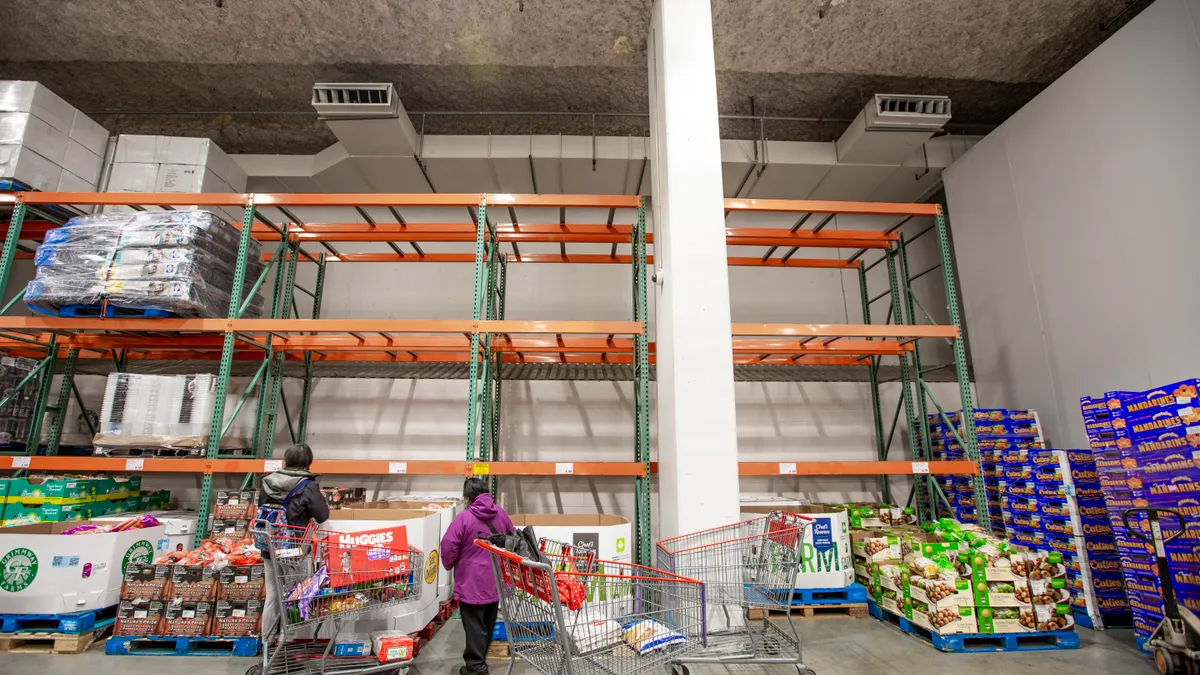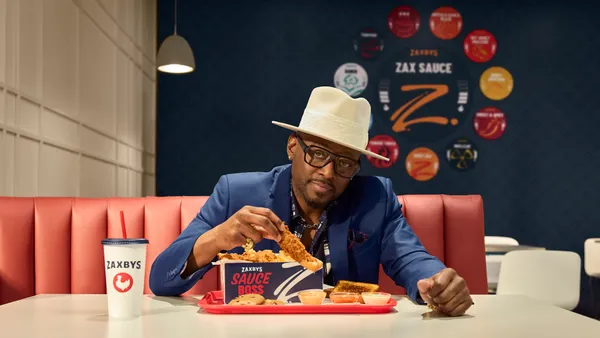As the coronavirus upends industries from travel to restaurants, the consumer packaged goods sector finds itself in an advantageous, but potentially more complex, position than most. Sales of essential household goods and packaged foods are strong as people pantry load and seek comfort during the pandemic, but key marketing levers are shut off, halting strategies and possibly forcing a pivot to new methods of outreach.
"CPG companies are thoroughly confused right now about how to behave, and as a result, a little bit paralyzed," Don Abraham, a senior partner at Kantar's consulting division, told Marketing Dive. "All of their retail and promotional strategies are up in the air right now. The retail environment right now is completely different from anything anybody's ever seen before."
The pandemic's public health and economic consequences — namely what's shaping up to be a potentially deep recession — will leave a long-lasting imprint on consumer behavior that could fundamentally alter marketing for the category in regards to everything from engagement to localization and retail partnerships. CPG marketers must prepare for those potential scenarios and build brand equity now, experts said, or risk losing their current gains and sense of stability as the economic situation worsens and a panic-buying period cools.
"If [CPGs] go dark and start to pull all marketing dollars, their road back is going to be more expensive," Marta Cyhan, CMO of shopper intelligence firm Catalina, told Marketing Dive. "It's almost like, if you've got momentum now with the business, it's more about how to maintain it."
Keeping the lights on
Hesitance from CPGs to push hard on marketing during the pandemic is understandable and influenced by a number of factors, including a focus on supply chain issues around getting enough product to store shelves. Messaging is another minefield as consumers express wariness toward brands perceived as capitalizing on a crisis and are extra sensitive to anything that could be associated with the coronavirus.
"Most CPG companies are fundamentally frozen at the moment waiting for a sign that, a) it's okay to do any sort of advertising and promotion, and b) they can't push people to store, so they're also struggling with what they are encouraging consumers to do," Abraham said.
Some CPGs also might simply not feel the need to do much marketing at the moment. Amid a consumer rush to stock up, sales for the category jumped 21% in the week ended March 28 compared to the year-ago period, per Nielsen data shared with Marketing Dive. Toilet paper sales alone were up nearly 50%.
"CPG companies are thoroughly confused right now about how to behave, and as a result, a little bit paralyzed."

Don Abraham
Kantar Consulting, senior partner
Beyond other products experiencing an expected bump during a pandemic, including disinfectant wipes and hand sanitizer, some surprising categories are seeing a resurgence. Kraft Heinz, battered in recent years as consumer tastes have shifted to more natural offerings, recently posted record manufacturing outputs as sales of offerings like macaroni and cheese soared, Food Dive reported. This trend is apparent even among demographics typically averse to processed packaged foods and frozen meals like millennials.
"The mindset is almost comfort-seeking and irrational," Cyhan said. "Right now, we've got consumers who are looking for connectivity, and then ... with this universal impact on income, everybody's looking for value."
However, there is no guarantee that those groups' interest will last through the coming months and after the worst of the pandemic passes, which means marketers must start thinking about sustaining engagement.
"Once they're down the aisle, the question is, how do you keep them?" Marsha McGraw, SVP and president of U.S. sales at Catalina, said. "What that narrative looks like, precisely to those consumers — those new consumers and those different demographics — is going to be critical to long-term success."
Building up loyalty could also be more important for CPGs as shortages make consumers less choosy about their brands and as private labels from retailers and sites like Amazon grow more popular. There was a 70-80% increase in purchases for retail-owned brands for the week ending April 4, per Cyhan, and 63% of shopper baskets had a retailer-branded product in them. Catalina recently launched a tracker that maps consumer shopping behavior state-by-state during the pandemic.
"Those shifts are happening, and if brands don't stay top of mind and relevant, it will be more expensive if not impossible to regain that momentum and those consumers back," Cyhan said.
Switching things up
CPGs haven't been entirely quiet on the marketing front. Kantar broke down the number of 30-second commercials that aired on the top 25 national TV networks by category amid the pandemic, with CPG posting gains. The firm found TV ads for household products were up more than 43% year-over-year for the week of March 23 and a staggering 84% the week prior, per data shared with Marketing Dive.
"What that narrative looks like, precisely to those consumers — those new consumers and those different demographics — is going to be critical to long-term success."

Marsha McGraw
Catalina, SVP and president of U.S. sales
Still, the coronavirus is accelerating a shift to digital and direct-to-consumer (DTC) models that could further depreciate traditional channels that were already declining pre-pandemic. The cancellation or postponement of the few remaining destination viewing events this year, namely the Olympics, means that a switch-up could be in order for CPGs looking to redirect their spend.
"The idea of large TV campaigns … those concepts have been struggling massively to still have the return they used to as we've gone to streaming more and more," Kantar's Abraham said. "This is really a huge opportunity for innovation of new ways of marketing that people have not tried before."
One area of opportunity that's emerged is cross-category partnerships. Restaurant delivery platforms such as DoorDash and UberEats are shifting to accommodate groceries and orders of home goods like toilet paper, Bloomberg reported. Convenience stores like 7-Eleven and other retail venues are ramping up similar offerings to meet customer demand and stay afloat as foot traffic plunges — but CPGs could potentially play a larger role in the space.
"The deli I got some stuff delivered from recently also, without any request from me, delivered toilet paper and paper towels," Abraham said. "If you're a marketer at a CPG company, you're trying to figure out what are the new partnerships that I should be striking up that I didn't think of before."
In the same way that national TV campaigns might be less effective, a national approach to retail promotions could also prove faulty. Different regions have responded to the coronavirus differently, and the enforcement of shelter-in-place orders, where all but nonessential businesses are forced to close, is inconsistent. For a CPG industry that has long struggled with localization efforts, the trend could make for a painful adjustment, but also a potentially necessary one as shopper habits might never return to the old normal.
"The key thing that marketers need to understand coming out of this is that COVID-19 and the coronavirus is nowhere near a uniform American experience," Abraham said.
"There's going to be a really uneven distribution across the country about where people are clamoring for DTC and where, frankly, people are looking forward to going back to stores the way they did before," he added. "I would argue that there won't be any 'regular old shopping.'"
Putting purpose back in the spotlight
It may be paramount in the coming months for CPGs to not only rethink where they do their marketing, but also what their messaging and creative look like.
"We're looking for somebody who actually gets the human element of this disaster ... That kind of messaging hasn't yet shown up in CPG."

Don Abraham
Kantar Consulting, senior partner
Brand purpose leaders in CPG like Procter & Gamble and Unilever have run donation-driven efforts and viral social media activations trying to combat the coronavirus and offset its financial impacts. Unilever's Dove recently shifted its long-running Real Beauty platform to highlight healthcare workers on the front lines of the pandemic and the marks that wearing masks has left on them, according to Ad Age. P&G did not return Marketing Dive's request for details on its marketing initiatives related to the coronavirus.
Yet, overall, CPG has been comparatively inactive in terms of purpose-led messaging. Historically stodgier categories such as automotive have in the meantime shifted into the spotlight, as brands like Ford, Hyundai, Jeep and Toyota drop vehicle-focused ads to address the pandemic.
"We're looking for somebody who actually gets the human element of this disaster," Abraham said. "That kind of messaging hasn't yet shown up in CPG."
Hygiene, health and wellness, along with an emphasis on human connection, will likely play a larger role as purpose messaging for CPGs evolves to fit the coronavirus era. Companies already championing such qualities in an authentic way will continue to perform well, according to Abraham, though he cautioned that CPGs must balance those positions with a renewed emphasis on sustainability.
"Ultimately, what we have to do is find a way to make sure that we're both being sustainable in our actions and hygienic," Abraham said.
"Everyone is on a mission from God to stay healthy right now. That's a question and a huge opportunity for the CPG companies," he added. "How do we help people feel the human connection that we're trying to drive, but also do it from a health and wellness perspective at the same time?"























